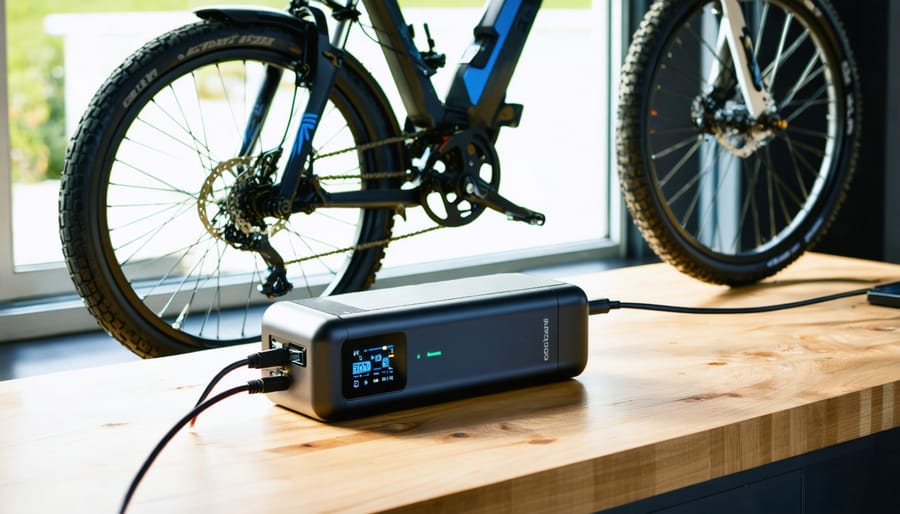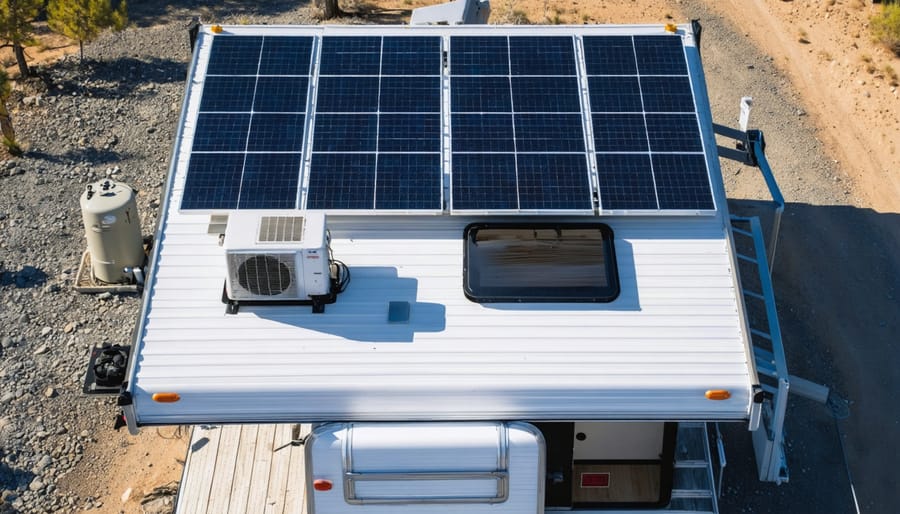What Does a Solar-Powered FM Receiver Transmitter Do?
Updated:

Solar-powered FM receiver transmitter or, shortly, solar-powered radio is a unique variant of a traditional FM receiver transmitter, with one significant difference: it doesn’t rely on batteries or any external electrical source. Instead, it harnesses solar power, turning it into electrical power through photovoltaic technology.
At first glance, a solar-powered radio resembles the standard radios we’re accustomed to, but the real magic lies within its self-sufficient power source.
Solar Power Radio Technology: Harnessing Sunlight for Sound
A solar-powered radio is a remarkable device that harnesses solar power to transmit and receive radio signals. This section will explain how it works, focusing on converting sunlight into sound.
At its core, a solar-powered FM receiver transmitter is an FM transceiver that transmits and receives FM radio signals.
The Basic Function of an FM Transceiver (Solar Powered Radio)
To understand how the solar-powered version works, it’s essential first to understand the basics of radio technology.
Transmitting and Receiving Signals
The FM transceiver operates in two main stages: transmitting and receiving signals.
The transmitting process begins with the microphone capturing voice input. This voice signal is then processed to create an input signal. The input signal is combined with a carrier frequency generated by the voltage-controlled oscillator (VCO). This process of combining the input signal with the carrier frequency is known as modulation.
The resulting modulated signal, which carries the information, is not sufficiently powerful to be transmitted through an antenna. Therefore, it is amplified in two stages:
- The exciter stage amplifies the signal power to one level of output. This stage also ensures the frequency stability of the signal, which is crucial for maintaining the integrity of the transmitted information.
- The power amplifier drives it to another power output level, now sufficient for the transmitter’s antenna. After the amplification, the signal reaches its final, or output, frequency, which is then ready to be transmitted through the antenna.
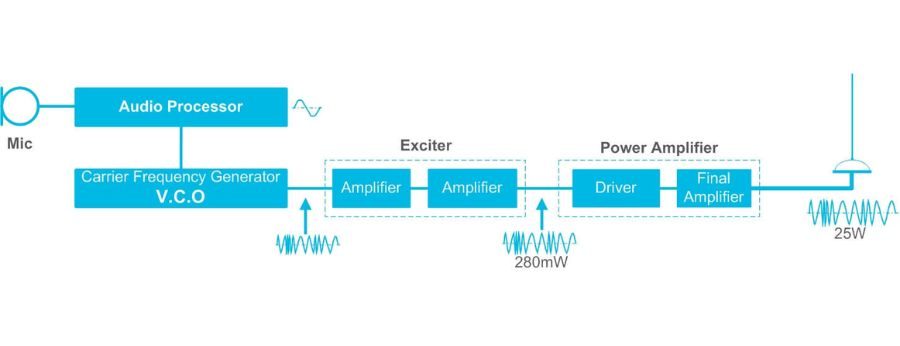
The receiving process starts when the transmission is captured by the receiver antenna and fed into an RF frequency selector. This selector can change frequency to tune into different transmissions. The transmission is combined with a carrier generated by a local VCO in a mixer.
The oscillator plays a crucial role in this process, ensuring the correct frequency is selected for demodulation.
The outcome is then put into a signal amplifier called an Intermediate Frequency (IF) booster. It lowers the signal pitch using a cleaning process that makes taking out the base signal easier. The signal is demodulated, and the result is fed into an audio section that amplifies the results so the user can feed into a speaker and hear it.
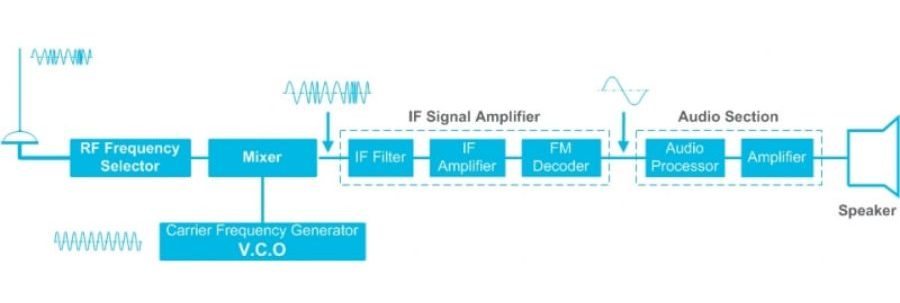
Powering the FM Transceiver with Solar Energy
The solar-powered radio operates similarly to a regular FM transceiver but with a critical difference: it uses solar energy to power its operations. Here’s how it harnesses sunlight to transmit and receive signals:
Solar Energy Collection
The device’s solar panels, made from monocrystalline or polycrystalline cells, are exposed to the sun. They absorb the light and convert it into electrical energy through a process known as the photovoltaic effect.
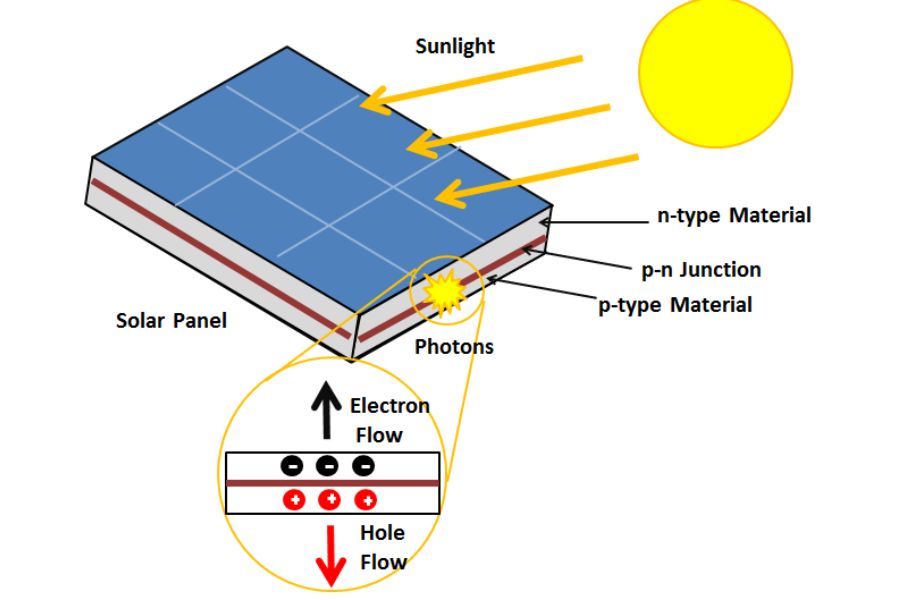
Energy Conversion and Storage
The absorbed sunlight is converted into electricity by semiconductors in the solar panels. When the sun’s light particles (photons) hit the semiconductors, they knock electrons loose from their atoms, creating an electrical current.
The generated electrical energy is used directly to power the FM transceiver or stored in a battery for later use. This allows the solar power radio to function even when there’s no light, such as at night or on cloudy days.
Powering the Transceiver
The stored electrical energy, whether directly from the solar panels or the battery, powers all the processes of the FM transceiver, from capturing voice input to transmitting and receiving signals.
Key Components of a Solar-Powered FM Receiver Transmitter
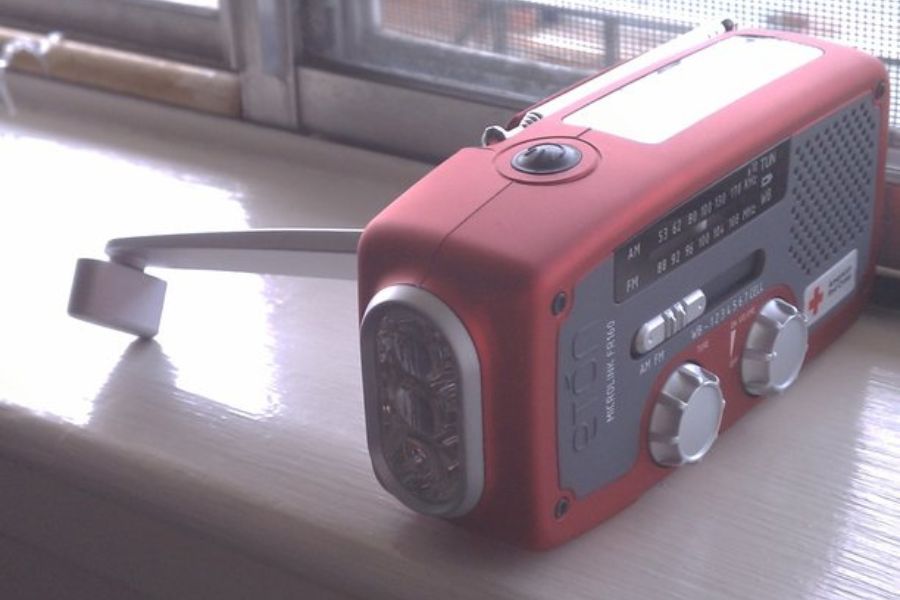
The ability of a solar-powered radio to convert light into sound is made possible by its key components: the solar panel, the battery, and the radio circuitry.
Solar Panel
The solar panel comprises multiple solar cells that convert sunlight into electricity. This electricity is then used to power the solar power radio directly or stored in a battery for later use.
Battery
The battery in a solar-powered radio serves as a storage unit for excess energy. It stores the extra energy that the solar panel generates during the day.
During low light or at night, the battery provides the stored energy to power the solar power radio, ensuring continuous operation.
Radio Circuitry
The radio circuitry is the component that processes the electrical signals. It converts the electrical signals, whether directly from the solar panel or the battery and converts them into sound.
This circuitry includes electronic components, such as transistors and semiconductors, amplifying and processing radio signals. Once processed, these signals are converted into audible sounds through a speaker.
Solar energy makes the FM receiver transmitter more environmentally friendly, cost-effective, and energy-efficient. However, the amount of light it receives can affect the device’s performance. Therefore, placing the device where it can get maximum sunlight is essential.
Real-World Applications of Solar-Powered Radio
Solar-powered radios are more than just interesting gadgets. They’re helpful, flexible, and can make a big difference in many real-life situations.
Solar-powered radios have several benefits: they’re easy to carry around, which makes them great for outdoor trips, and you don’t need extra batteries or power outlets. They’re also very helpful in remote areas without grid access, giving people a way to get important news and entertainment.
A solar radio can be a reliable communication method in places where power outages are common, especially in emergencies. So, let’s look into some of the applications.
Emergency Communication
In the wake of a natural disaster, communication networks often go down. Solar-powered radios can step in to fill this gap. They don’t rely on the grid, making them an invaluable tool for emergency response teams.
With these devices, rescuers can coordinate their efforts more effectively, potentially saving more lives.
Remote Areas
Staying connected can be challenging for people living or working in remote areas. Solar-powered radios offer a solution.
Whether you’re a scientist conducting field research in the wilderness, a park ranger overseeing a vast natural reserve, or a resident in a rural community, these devices can provide a reliable means of communication powered by the sun.
Sustainable Broadcasting
Community radio stations can use solar-powered radio to broadcast their programs without relying on traditional power sources. This reduces their carbon footprint and makes broadcasting possible in areas where electricity is scarce or unreliable.
Educational Purposes
Solar FM transceivers are also excellent educational tools. They can be used in classrooms to teach students about radio communication, solar energy, and electronics.
Building a simple solar-powered radio can be a fun and educational project that provides hands-on experience with these concepts.
Case Studies-Empowering Communities and Solving Problems
Solar-powered radios are making a significant difference worldwide, from impoverished countries to developed nations. This section explores diverse case studies highlighting these solar-powered devices’ universal appeal and transformative potential.
Solar-Powered Communication in Mountain Rescue Operations
(Case Study Source: https://www.wildtalk.com/case-studies/solar-powered-search-and-rescue-vhf-uhf/)
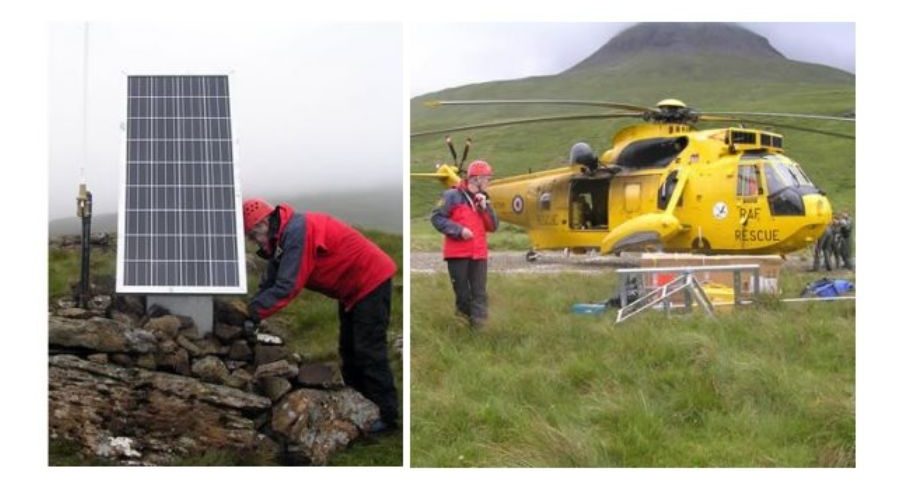
The Challenge
The Skye Mountain Rescue Team, operating in the rugged Cuillin mountain range, faced a significant challenge. They needed to establish seamless radio communication to rapidly rescue fallen walkers and climbers across the mountain range.
However, the lack of mains electricity at two repeater locations required a renewable power source.
The Power Problem
The repeaters, essential for radio communication, are power-hungry devices. Given the environmental and practical constraints of wind turbines and hydropower, solar PV panels were the only feasible solution.
However, the high power consumption of the repeaters meant that a large array of commercial solar panels and batteries would be needed, especially during the winter days with no sun or snow cover.
Innovative Solution by Wildtalk
Wildtalk, a company specializing in radio communication solutions, took an innovative approach to this problem. Instead of trying to generate more energy, they focused on reducing the energy consumption of the repeaters.
They designed a solar-powered radio that reduced the 10-watt power consumption of a standard repeater down to just 0.2 Watts. This reduction to 1/50th of the original consumption led to a similar reduction in the area of panels, the amount of batteries required, and nearly 1/50th of the cost.
Successful Implementation and Results
The repeater power saver designed by Wildtalk is currently in use at two locations on Skye. It has worked flawlessly through three full winter seasons of heavy snow, fierce winds, and heavy rains. The power saver, an add-on unit, can be attached to most existing repeaters.
Wildtalk can also supply its repeater configured to give over-the-air battery warnings and other simple telemetry to monitor and control.
Conclusion: The Power of Solar-Powered FM Receiver Transmitters
This case study underscores the potential of solar-powered radio to provide reliable communication in remote and challenging environments. By reducing energy consumption, Wildtalk was able to implement an environmentally friendly and cost-effective solution.
This is a compelling example of the innovative applications of solar-powered FM receiver transmitters, demonstrating their crucial role in life-saving operations.
Empowering Zambian Women Farmers with Solar-Powered Radios
(Case Study Source: https://www.lifelineenergy.org/why-radio-is-you-for-women-farmers-in-zambia/)
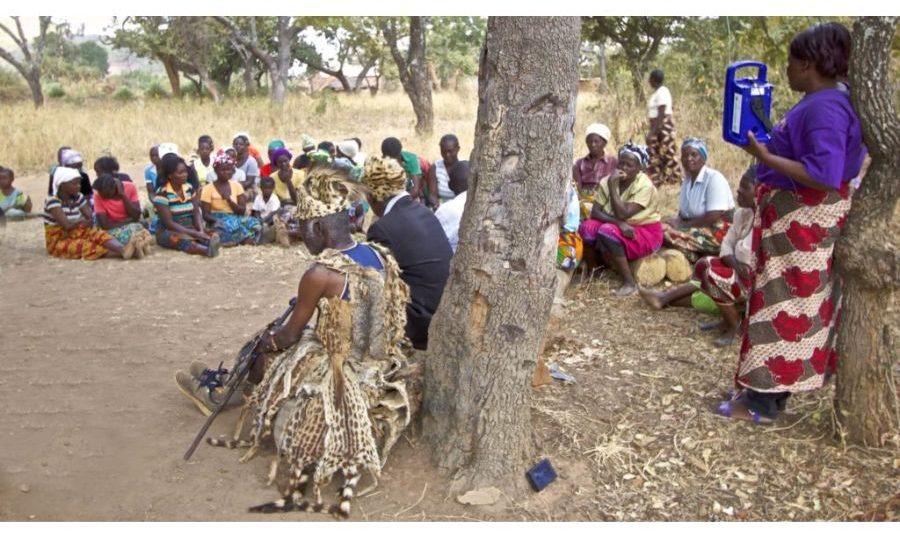
The Challenge
In Zambia, a significant portion of the farming community comprises women with limited access to vital farming information due to the lack of resources to power traditional radios.
The Community Markets for Conservation (COMACO) identified this gap and sought to bridge it.
Solar Radios: A Game Changer
To address this issue, COMACO introduced farmer radio programs in 2013 and distributed over 2,000 solar-powered and wind-up radios to farmer groups.
These radios, not requiring traditional batteries, became a reliable source of information for these women farmers, enabling them to tune into the weekly Farm Talk show.
This program provided valuable insights on various topics, including conservation farming, nutrition, gender and family planning, family business, leadership development, and livestock care.
Impact on Women Farmers
The introduction of solar radios brought about a significant transformation in the lives of women farmers in Zambia. With access to relevant information, they could acquire new skills, such as poultry production, and learn about different income-generating opportunities.
The radios also served as an effective medium to overcome the literacy barrier, as many women farmers could not read written information. As a result, they started participating in activities like village banking and conservation farming, improving their livelihoods and reducing poverty levels.
Conclusion: The Power of Solar-Powered FM Receiver Transmitters
This case study underscores the transformative potential of solar power. By providing a reliable and accessible source of information, solar radio has empowered women farmers in Zambia, leading to improved livelihoods and reduced poverty.
This is a compelling example of how solar-powered FM receiver transmitters can address socio-economic challenges, reinforcing their importance in today’s world.
Solar Radios: A Lifeline for Orphaned Children in Post-Genocide Rwanda
(Case Study Source: https://www.lifelineenergy.org/cow-doesnt-give-me-information-radio-played-role-children-post-genocide-rwanda/)
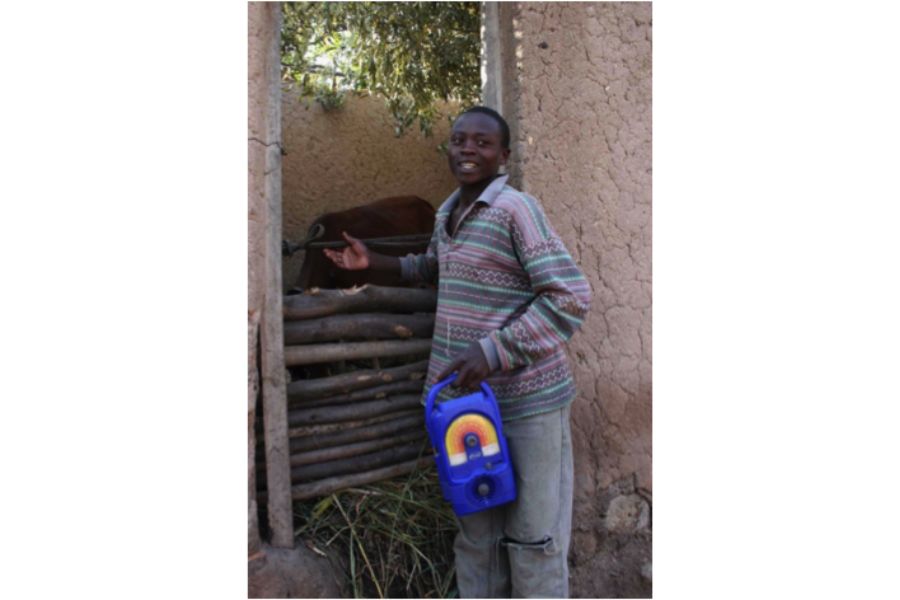
The Challenge
In the aftermath of the 1994 Rwandan genocide, the country was left with an estimated one million orphaned children. Many of these children, like Fordward, an 18-year-old who became the head of his household at 11, were forced to take on adult responsibilities without access to essential information and knowledge.
For many, the high expense of rechargeable batteries made it impossible to own radios, a vital source of information.
Solar Radios: A Beacon of Hope
Project Muraho, initiated by Lifeline Energy, addressed this issue. Between 1999 and 2011, they handed out over 15,500 solar radios to families in Rwanda that children or widows led. These radio receivers, not requiring traditional batteries, became a reliable source of information for these children.
When asked if he had to choose between his wind-up radio or his cow, Forward didn’t hesitate. He said, “I shall choose my radio because a cow doesn’t give me information.” The radios offered practical advice on health, hygiene, farming, livestock care, weather, and children’s rights in their language, Kinyarwanda.
Impact on Orphaned Children
The solar radios had a profound impact on the lives of these children. They eased their isolation, made them feel safe, and provided them with trusted voices that offered advice and guidance.
The radio also played a significant role in dispelling rumors and providing accurate news, which was particularly important in a country still dealing with the aftermath of a genocide.
Conclusion: The Power of Solar-Powered FM Receiver Transmitters
This case study underscores the transformative potential of solar-powered FM receiver transmitters. By providing a reliable and accessible source of information, these devices have played a crucial role in the recovery and rebuilding process in post-genocide Rwanda.
This is a compelling example of how solar-powered FM receiver transmitters can address socio-economic challenges and provide hope in adversity.









